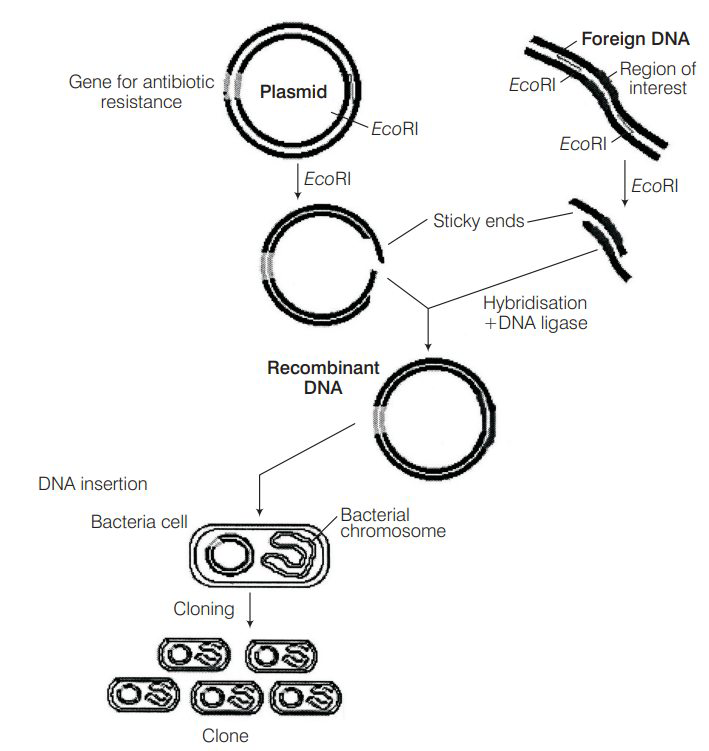When a foreign DNA is introduced into an organism, how is it maintained in the host and how is it transferred to the progeny of the organism?
Foreign gene is usually ligated to a plasmid vector and introduced in the host. As plasmid replicates, and makes multiple copies of itself, so does the foreign gene gets replicated and its several copies are made. When the host organism divides, its progeny also receives the plasmid. DNA containing the foreign gene.
The whole process can be visualised in the figure given below

Bt cotton is resistant to pest, such as lepidopteran, dipterans and coleopterans. Is Bt cotton also resistant to other pests as well?
Bt cotton is made resistant to certain specific taxa of pests (lepidopteran, dipterans and coleopterans). It is quite likely that in future, some other pests may infest these Bt-cotton plants. It is similar to immunisation against smallpox which does not provide immunity against other pathogens like those, that causes cholera, typhoid etc.
$$ \text { A patient is suffering from ADA deficiency. Can he be cured? How? } $$
ADA enzyme is crucial for the immune system to function. Deletion of the gene for adenosine deaminase results into ADA deficiency.
In some children, ADA deficiency can be cured by bone-marrow transplantation, while in others it can be treated by enzyme replacement therapy, in which functional ADA is given to the patient by injection. But the problem with both of these approaches is that they are not completely curative.
It may recurrent in nature as in the process of gene therapy, lymphocytes used are found not to be immortal in nature and the patient requires a periodic infusion of such genetically engineered lymphocytes.
For permanent cure, gene isolated from the bone-marrow cells producing ADA is introduced into cells at early embryonic stages.
Define transgenic animals. Explain in detail any four areas where they can be utilised.
Animals that have had their DNA manipulated to possess and express an extra (foreign) gene are known as transgenic animals.
Following are the four main areas where they can be utilised
(i) To Study Normal Physiology and Development
These animals can be used to study that which factor/gene products are needed at what time of development. By the expression of certain genes, they help scientists to understand the normal gene expression at various stages of growth and development.
(ii) Study of Diseases
Transgenic animals can be created to serve as models for various human diseases. They also help us to understand the involvement of various genes in diseases like cancer, Parkinson' disease etc.
(iii) Vaccine Safety
Transgenic animals can be used to test vaccines like polio vaccine. Transgenic mice have shown promising results in this area and would replace the vaccine testing on monkeys in the years to come.
(iv) Chemical Safety Testing
Transgenic animals are created which are more sensitive to certain chemicals/drugs. These are used to study the toxicity or side effects of that chemical/drug. The advantage is that we get results faster.
You have identified a useful gene in bacteria. Make a flow chart of the steps that you would follow to transfer this gene to a plant.
After identifying a useful gene in bacteria, following steps should be followed
(i) Isolation of useful gene using restriction endonucleases
$$ \downarrow $$
(ii) Transferring the gene to a suitable vector to create a recombinant DNA molecule
$$ \downarrow $$
(iii) Transfer of these recombinant DNA molecules to the target cells.
$$ \downarrow $$
(iv) Screening of cells for transformation
$$ \downarrow $$
(v) Selection of transformed cells
$$ \downarrow $$
(vi) Regeneration of plants from the transformed cells to get transgenic plants.